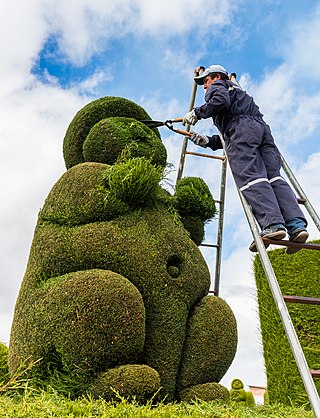
Gardening is the practice of growing and cultivating plants as part of horticulture. In gardens, ornamental plants are often grown for their flowers, foliage, or overall appearance; useful plants, such as root vegetables, leaf vegetables, fruits, and herbs, are grown for consumption, for use as dyes, or for medicinal or cosmetic use.
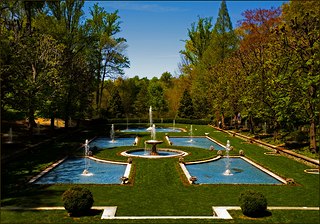
Longwood Gardens is a botanical garden that consists of over 1,077 acres of gardens, woodlands, and meadows in Kennett Square, Pennsylvania, United States in the Brandywine Creek Valley. It is one of the premier horticultural display gardens in the United States and is open to visitors year-round to enjoy native and exotic plants and horticulture, events and performances, seasonal and themed attractions, as well as educational lectures, courses, and workshops.

VanDusen Botanical Garden is a botanical garden situated in Vancouver, British Columbia, in the Shaughnessy neighborhood. It is located at the northwest corner of 37th Avenue and Oak Street. It is named for local lumberman and philanthropist Whitford Julian VanDusen.

Seed companies produce and sell seeds for flowers, fruits and vegetables to commercial growers and amateur gardeners. The production of seed is a multibillion-dollar business, which uses growing facilities and growing locations worldwide. While most of the seed is produced by large specialist growers, large amounts are also produced by small growers that produce only one to a few crop types. The larger companies supply seed both to commercial resellers and wholesalers. The resellers and wholesalers sell to vegetable and fruit growers, and to companies who package seed into packets and sell them on to the amateur gardener.

New England Botanic Garden at Tower Hill is a 171-acre botanic garden and arboretum located in Boylston, Massachusetts, approximately 8 miles (13 km) north of central Worcester in Worcester County, Massachusetts. The Garden features 18 distinct gardens, preserved woodlands, and miles of walking trails.

The Cheyenne Botanic Gardens are located in Lions Park in Cheyenne, Wyoming, with an associated High Plains Arboretum located five miles (8 km) northwest of Cheyenne at an elevation of 6,200 feet (1,900 m).

The California State University Northridge Botanic Garden or CSUN Botanic Garden is located in the northern San Fernando Valley, in the southeast section ("quadrant") of the California State University, Northridge campus in the community of Northridge in Los Angeles, California.

Powell Gardens, Kansas City's botanical garden, is a 970-acre (3.9 km2) botanical garden in Kingsville, Missouri, United States, 30 miles (48 km) east of Kansas City. It features 6,000 varieties of plants, with 225,000 plants in seasonal displays, and is open to the public, for a fee, during daylight hours.
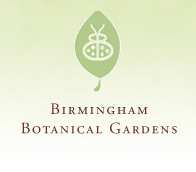
The Birmingham Botanical Gardens is 67.5-acre (27.3 ha) of botanical gardens located adjacent to Lane Park at the southern foot of Red Mountain in Birmingham, Alabama. The gardens are home to over 12,000 different types of plants, 25 unique gardens, more than 30 works of original outdoor sculpture, and several miles of walking paths. With more than 350,000 annual visitors, the Birmingham Botanical Gardens qualify as one of Alabama's top free-admittance tourist attractions. The Birmingham Botanical Gardens is also a part of the American Public Gardens Association.

The Idaho Botanical Garden, located in the historic Old Penitentiary District of Boise, Idaho, is a 501(c)(3) nonprofit organization dedicated to connecting people, plants, and nature. The Garden serves as a gathering space in the Boise community and advocates environmental stewardship. Spanning 15 acres, the Idaho Botanical Garden is a premier collection of plants cultivated for the unique sagebrush steppe ecosystem of the Treasure Valley aimed at showcasing the region's biodiversity.

The Michigan State University Horticulture Gardens are horticultural gardens, with a landscape arboretum, located on Bogue Street on the Michigan State University campus in East Lansing, Michigan. The gardens are open to the public daily without charge.

The Chicago Botanic Garden is a 385-acre (156 ha) living plant museum situated on nine islands in the Cook County Forest Preserves. It features 27 display gardens and five natural habitats including Mary Mix McDonald Woods, Barbara Brown Nature Reserve, Dixon Prairie, the Skokie River Corridor, and the Lakes and Shorelines. The garden is open every day of the year. An admission fee has been approved to start in 2022, not to exceed $35.
Fellows Riverside Gardens are public botanical gardens, part of the Mill Creek Metro Parks system. The gardens are located at 123 McKinley Avenue, in Youngstown, Ohio, United States. They are open daily with no admission fee.
This is an alphabetical index of articles related to gardening.

The North Carolina Botanical Garden is a botanical garden operated by the University of North Carolina at Chapel Hill in Chapel Hill, North Carolina. The primary goal of the Garden is to research, catalog, and promote the native plant species of North Carolina.
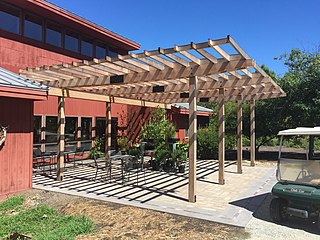
Adkins Arboretum is a 400-acre native garden and arboretum located within Tuckahoe State Park at 12610 Eveland Road, Ridgely, Maryland. The grounds contain five miles of paths through meadows and native plant gardens on the Eastern Shore of Maryland. Its gardens contain a "living collection" of more than 600 species of native shrubs, trees, wildflowers and grasses, used to promote land stewardship practices in the Chesapeake Bay region.

Urban horticulture is the science and study of the growing plants in an urban environment. It focuses on the functional use of horticulture so as to maintain and improve the surrounding urban area. Urban horticulture has seen an increase in attention with the global trend of urbanization and works to study the harvest, aesthetic, architectural, recreational and psychological purposes and effects of plants in urban environments.
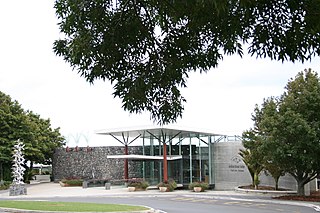
Auckland Botanic Gardens is a botanical garden in the New Zealand city of Auckland. It is located in the suburb of Manurewa, in the Manurewa Local Board Area. The gardens cover 64 hectares, and holds more than 10,000 plants.

The Royal Danish Horticultural Society's Garden is a garden in the Frederiksberg district of Copenhagen, Denmark operated by the Danish Horticultural Society as a source of inspiration for its members as well as other people with an interest in gardening. It is situated on Frederiksberg Runddel, just left of the main entrance to Frederiksberg Gardens.

Foodscaping is a modern term for the practice of integrating edible plants into ornamental landscapes. It is also referred to as edible landscaping and has been described as a crossbreed between landscaping and farming. As an ideology, foodscaping aims to show that edible plants are not only consumable but can also be appreciated for their aesthetic qualities. Foodscaping spaces are seen as multi-functional landscapes which are visually attractive and also provide edible returns. Foodscaping is a great way to provide fresh food in an affordable way.





















